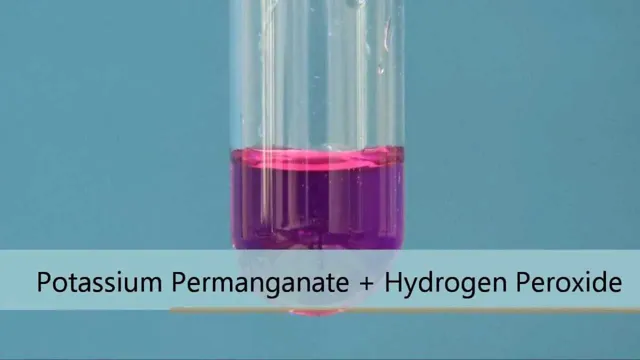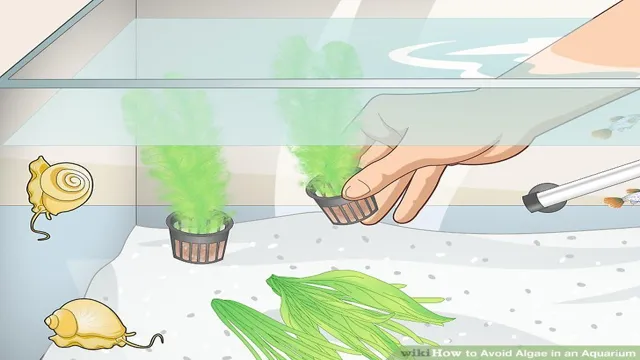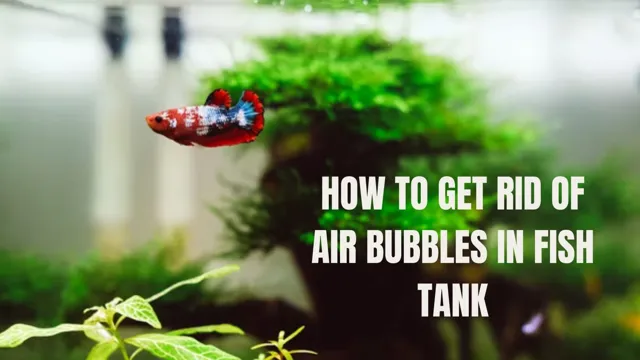Have you ever experienced water discoloration in your aquarium or fish tank? If so, you may have come across the term “potassium permanganate.” Potassium permanganate is a powerful oxidizer that is often used to disinfect aquariums and treat various fish diseases. However, it can leave behind nasty brown stains and is highly toxic to fish and aquatic life if not used properly.
So, what can you do to deactivate potassium permanganate and keep your aquarium free from harm? One effective solution is to use hydrogen peroxide. In this blog post, we will explore the process of deactivating potassium permanganate with hydrogen peroxide, why it works, and its benefits for aquarium owners. So, grab a cup of coffee, sit back, and let’s dive into the fascinating world of aquarium maintenance!
Understanding Potassium Permanganate
Potassium permanganate is a popular aquarium water treatment option that is effective in killing harmful bacteria, parasites, and fungus. However, excessive use can lead to negative effects on aquatic life, including fish and plants. If you accidentally add too much potassium permanganate to your aquarium water, it’s essential to know how to deactivate it quickly before any harm is done.
One effective way to deactivate it is by using hydrogen peroxide. Hydrogen peroxide oxidizes potassium permanganate, creating water and manganese dioxide. This process can take several hours, but it is a safe and reliable way to neutralize any excess potassium permanganate.
Remember to follow the recommended dosage for potassium permanganate in your aquarium and always exercise caution when using any chemicals in your aquatic environment.
What is Potassium Permanganate?
Potassium permanganate is a powerful oxidizing agent, commonly used in the medical, industrial, and water treatment industries. It appears as a deep purple crystal, dissolving easily in water to yield a bright purple solution. Due to its strong oxidizing properties, it has been used as a disinfectant, deodorizer, and wound cleanser.
It is also used in the mining industry for flotation, where it helps in separating minerals from ore. Potassium permanganate is also found in gardening, where it is used to treat fungal infections and parasites in plants. While it has numerous benefits, it should be handled with caution because prolonged exposure to it can result in skin and respiratory irritation.
When handling potassium permanganate, always wear gloves and make sure to store it in a cool and dry place.

Why is it Used in Aquariums?
Potassium Permanganate is commonly used in aquariums to treat a range of different water issues. It’s a powerful oxidizer that can help to remove organic materials and harmful microorganisms, making it a potent tool for maintaining a healthy and stable aquatic environment. One of the primary uses of Potassium Permanganate in aquariums is to eliminate harmful parasites and bacteria that can cause diseases in fish or other aquatic species.
It’s also used to address issues such as algae blooms and high organic loads in the water. When using Potassium Permanganate in an aquarium, however, it’s vital to remember that it must be used in the right amounts and under the correct conditions. Overuse or misuse can be dangerous and may cause more harm than good.
Therefore, it’s essential to follow all recommended guidelines for use and consult with a knowledgeable aquarium professional before starting any treatments. Ultimately, though, for aquarium enthusiasts looking for an effective and reliable way to keep their aquatic ecosystems healthy and thriving, Potassium Permanganate could be just what they need.
Risks of Potassium Permanganate in Aquariums
Potassium permanganate is commonly used in aquariums to treat various infections and parasites. However, it can be risky if not used properly. This chemical compound is highly reactive and can cause harm to both aquatic life and humans if it comes in contact with them. (See Also: How to Glue Aquarium Stones: A Step-by-Step Guide for Perfectly Bonded Aquatic Decor)
It can damage gills and fins of fish and also cause chemical burns to human skin. Therefore, it is essential to know how to deactivate potassium permanganate with peroxide in aquariums to ensure the safety of everyone involved. When using potassium permanganate, always wear gloves and goggles to protect yourself from potential harm.
After use, add hydrogen peroxide to the aquarium water to neutralize the potassium permanganate. This will prevent any residual potassium permanganate from harming your fish and other aquatic life in the tank. Overall, using potassium permanganate in aquariums can be beneficial, but it is crucial to handle it with care to avoid any potential risks.
The Dangers of Overdosing
Potassium Permanganate Aquarium owners are always looking for effective ways to keep their fish healthy and the water clear. One popular option is using potassium permanganate, a chemical that can kill parasites, bacteria, and fungus. However, it’s important to note that overdosing this substance can be extremely dangerous for fish and other aquatic creatures.
Potassium permanganate is a powerful oxidizing agent that reacts strongly with organic matter. When too much is added to an aquarium, it can lead to a burst of oxidation. This can quickly rob the water of oxygen, suffocating any fish in the tank.
Additionally, potassium permanganate can also cause chemical burns to delicate gills and fins. To prevent these risks, aquarium owners should always follow dosage instructions carefully and never go over the recommended amount. It’s always better to err on the side of caution and monitor the tank closely for any signs of distress or harm to the aquatic life.
How it Can Harm your Fish and Other Inhabitants
Potassium permanganate is commonly used in aquariums to treat various infections and parasites. However, it can harm your fish and other inhabitants if not used properly. One of the major risks of using potassium permanganate is overdosing, which can cause toxicity in the aquarium.
This chemical can also destroy beneficial bacteria, disrupt the natural balance of the aquarium, and harm any sensitive plants or invertebrates. Additionally, potassium permanganate can irritate the skin and eyes if not handled properly. It is important to follow the dosage instructions carefully, conduct water changes before and after treatment, and monitor the tank closely during treatment to ensure the safety of your aquatic pets.
Using potassium permanganate in your aquarium should be done with caution and only when necessary.
Using Hydrogen Peroxide to Deactivate Potassium Permanganate
When it comes to maintaining a healthy aquarium, it’s important to understand how to deactivate potassium permanganate with hydrogen peroxide. Potassium permanganate is commonly used to treat various aquarium ailments, but if not neutralized properly, it can harm beneficial bacteria and even fish. To deactivate it, simply mix hydrogen peroxide into the aquarium water.
The peroxide will react with the potassium permanganate, breaking it down into harmless compounds. It’s crucial to use the right ratio of hydrogen peroxide to water, as too much can also harm aquatic life. With careful monitoring and the right precautions, using hydrogen peroxide to deactivate potassium permanganate can be a safe and effective method for keeping your aquarium healthy and vibrant.
What is Hydrogen Peroxide and How Does it Work?
Hydrogen Peroxide Hydrogen peroxide is a powerful oxidizer commonly used as a disinfectant and bleaching agent. It works by releasing oxygen atoms that attach themselves to organic materials and break them down into simpler compounds. This process results in the production of water and oxygen gas, making it an effective and eco-friendly cleaning agent.
Interestingly, hydrogen peroxide can also be used to deactivate potassium permanganate, a strong oxidizer used in various chemical reactions. By adding hydrogen peroxide to a solution of potassium permanganate, it reacts with the oxygen atoms and decomposes the compound into manganese oxide, water, and oxygen gas. This reaction is exothermic, producing heat and may result in bursts of gas if not allowed to react in a controlled manner. (See Also: How to Kill Black Hair Algae in Aquarium: Effective Tips and Methods)
Always exercise caution when handling these chemicals and follow proper safety protocols.
Preparing your Aquarium for Hydrogen Peroxide Treatment
If you’re using potassium permanganate to treat your aquarium, it’s crucial to prepare for the deactivation process with hydrogen peroxide if you want to ensure the health of your aquatic animals and plants. Before using hydrogen peroxide, make sure to check the compatibility of your aquatic life, since certain organisms may be sensitive to this solution, and it’s important to remove any carbon filtration media or activated carbon to prevent absorption. Test the water chemistry before and after the treatment to ensure that the hydrogen peroxide has been neutralized.
To deactivate potassium permanganate with hydrogen peroxide, dilute the solution in a bucket of tank water and slowly add it to the aquarium until the water turns clear, indicating that the potassium permanganate has been deactivated. This simple process can save your plants and animals from the toxic effects of potassium permanganate, and keep your aquarium healthy and clean.
Step-by-Step Guide to Deactivating Potassium Permanganate with Hydrogen Peroxide
Deactivating Potassium Permanganate with Hydrogen Peroxide Potassium permanganate is a powerful oxidizer that is often used in water treatment plants. However, its residuals can cause discoloration and taste issues in drinking water. To prevent this, hydrogen peroxide can be used to deactivate potassium permanganate prior to water distribution.
Here is a step-by-step guide on how to do it. First, add hydrogen peroxide to the solution containing potassium permanganate slowly and carefully. Next, mix the solution thoroughly using a stirrer until a homogenous mixture is achieved.
The hydrogen peroxide will react with the potassium permanganate, forming manganese dioxide and oxygen gas. This reaction needs to be accelerated to ensure complete deactivation, so the mixture should be heated up to 50°C for at least 10 minutes. Finally, let the mixture cool down and store it in a clean, sealed container until needed.
By following this process, you can effectively deactivate potassium permanganate and avoid any negative effects on drinking water quality.
Conclusion
In conclusion, deactivating potassium permanganate with hydrogen peroxide in your aquarium may seem like a daunting task, but with the right approach, it’s as easy as making fish faces at your aquatic friends. Remember, safety first, and always follow the proper dosage instructions. With a little patience and care, your aquarium will not only look pristine but also remain a healthy and thriving ecosystem for your beloved fish friends.
Happy deactivating!”
Safety Measures to Take When Working with Chemicals in Your Aquarium
When working with chemicals in your aquarium, it’s important to take the necessary safety measures to protect yourself and your aquatic pets. One common chemical used in aquarium maintenance is potassium permanganate, which is used to treat bacteria and parasites. However, if not properly deactivated, it can harm your fish and invertebrates.
One way to neutralize potassium permanganate is by using hydrogen peroxide. Simply add a small amount of hydrogen peroxide to the water and wait for the solution to clear up. This indicates that the potassium permanganate has been successfully neutralized and it’s now safe to continue with your aquarium maintenance. (See Also: How to Make Aquarium Acidic: Tips and Tricks for Maintaining Optimal Water pH for your Fish)
Remember, always handle chemicals with care and follow the instructions carefully to ensure the safety of everyone involved.
FAQs
What is potassium permanganate and why is it used in aquariums?
Potassium permanganate is a strong oxidizing agent used in aquariums to treat various bacterial, fungal, and parasitic infections in fish. It is also used to disinfect plants and aquarium equipment.
How does potassium permanganate work in aquariums?
Potassium permanganate works by oxidizing organic matter, including harmful bacteria, fungi, and parasites in the water, and can also eliminate algae and other undesirable organisms. It is a potent disinfectant and also helps to improve water quality.
Is potassium permanganate safe for aquariums?
Potassium permanganate can be safe for aquariums when used correctly and in the appropriate concentration. However, it can be toxic to fish and invertebrates if not used properly, so it is important to follow dosing instructions carefully and monitor water quality closely.
How do you deactivate potassium permanganate in aquarium water?
Potassium permanganate can be deactivated by adding hydrogen peroxide to the water, which will break down the chemical and make it safe for fish and other aquatic life. It is important to add the hydrogen peroxide slowly and over time, and to monitor water quality closely after deactivation.
Can you use vinegar to deactivate potassium permanganate in aquarium water?
No, vinegar is not an effective method for deactivating potassium permanganate in aquarium water. Hydrogen peroxide is the most effective and safest method for deactivating this chemical.
How long does it take for potassium permanganate to be deactivated in aquarium water?
The deactivation process for potassium permanganate can take several hours, depending on the concentration of the chemical in the water. It is important to add the hydrogen peroxide slowly and monitor water quality closely during this process.
How can you prevent the need for using potassium permanganate in your aquarium?
Maintaining good water quality, avoiding overfeeding, and quarantining new fish can help prevent the need to use potassium permanganate in your aquarium. Regular water changes and proper filter maintenance can also help keep your aquarium healthy and free of harmful bacteria and parasites.







